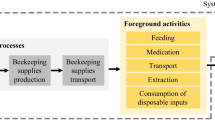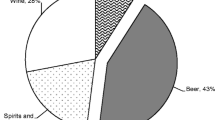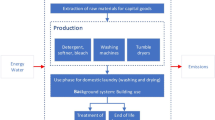Abstract
Purpose
The primary purpose of this study is to estimate the life cycle greenhouse gas (GHG) emissions (carbon footprint) and criteria pollutant emissions during honey production and processing for US conditions based on several case studies of different scale beekeeping and processing operations. Commercial beekeeping operations yield two coproducts, honey and pollination services. These two products present an interesting coproduct allocation problem since beekeeping operations cannot be clearly subdivided, pollination services do not have a substitutable product or service, and pollination services cannot be characterized by physical properties for value-based allocation. Thus, a secondary purpose is to identify an appropriate allocation method and to discuss how the choice of allocation strategies influences the outcomes.
Methods
The commercial honey production supply chain comprises the following two primary steps: raw honey production by beekeepers and honey processing and packaging by processors. A case study approach was used based on detailed operation data provided by several beekeepers and processors from key honey-producing regions in the USA. Process-based life cycle assessment was conducted following the ISO guidelines, and economic allocation was used as a baseline method for coproduct allocation.
Results and discussion
Life cycle modeling of one complete commercial supply chain (raw honey production, transport to a processer, and processing) shows that total life cycle GHG emissions range from 0.67 to 0.92 kg CO2 equivalent/kg of processed honey; however, outcomes show significant variability. Results show commercial honey production emits more GHGs and criteria pollutants than processing. Truck transport of bees is the dominant contributor of both GHG emissions and criteria pollutants within the life cycle of raw honey production. However, honey processing, which depends on natural gas and electricity, contributes a significant fraction of SO x . These results are based on economic allocation among beekeeping coproducts. In addition to economic allocation, subdivision was applied to beekeeping activities. Because hive management (feed and medication) could not be further subdivided, a bounded range was generated for raw honey production, where the lower and upper bounds represent two extremes where all the environmental burdens associated with hive management were allocated to pollination or honey production.
Conclusions
Economic allocation tends to fall near or below the lower bound for the subdivision method. Interestingly, some beekeepers reported that their hive management practices were driven more by demand for pollination services than honey, which seems to be reflected in the coordination of lower-bound subdivision and economic allocation results.






Similar content being viewed by others
References
Allsopp MH, De Lange WJ, Veldtman R (2008) Valuing insect pollination services with cost of replacement. PLoS One 3(8):e3128
Cornell University the Master Beekeeper Program (2006) Seasonal bee management calendar. Available from http://www.masterbeekeeper.org/calendar/calendar_one.htm. Accessed July 2010
Ecoinvent Centre (2007) Ecoinvent Data v2.0. Swiss Center for Life Cycle Assessment, Dübendorf
Ekvall T, Finnveden GR (2001) Allocation in ISO 14041—a critical review. J Clean Prod 9:197–208
Intergovernmental Panel on Climate Change (2007) IPCC fourth assessment report: climate change 2007—the physical science basis. Cambridge University Press, Cambridge
International Organization for Standardization (2006) ISO 14041. Environmental management – Life cycle assessment – Goal and scope definition and inventory analysis. Geneva
Johnson R (2010) Honey bee colony collapse disorder. Congressional Research Service, Washington
Kremen C, Williams NM, Thorpe RW (2002) Crop pollination from native bees at risk from agricultural intensification. P Natl Acad Sci USA 99(26):16812–16816
Melathopoulos A (2006) Honey as Canada’s sustainable and ethical sweetener. Hivelights 19(2):14–17
Ministry of Agriculture and Forestry (2001) A review of treatment options for control of varroa mite in New Zealand. HortResearch Client Report No. 2001/249. Ministry of Agriculture and Forestry, Palmerston North
Morse RA (2000) The value of honey bees as pollinatiors of U.S. crops in 2000. Bee Culture 128:1–151
National Renewable Energy Laboratory (2008) U.S. Life-Cycle Inventory Database. Available from http://www.nrel.gov/lci/database/. Accessed June 2010
PE International (2009) GaBi 4 software-system and databases for life cycle engineering, Leinfelden-Echterdingen, Germany
Pimentel D, Wilson C, McCullum C, Huan R, Dwen P, Flack J, Tran Q, Saltman T, Cliff B (1997) Economic and environmental benefits of biodiversity. BioScience 47(11):747–757
PRé Consultants (2008) SimaPro 7.1. Amersfoort, The Netherlands
Rose BJ, Grabham S (2009) GHG energy calc help. Available from http://www.ghgenergycalc.com.au/freestuff/GHGEnergyCalcHelp.pdf. Accessed August 2010
Sumner DA, Boriss H (2006) Bee-conomics and the leap in pollination fees. Agricultural and Resource Economics Update 9(3):9–11
Thomas MG, Schumann DR (1993) Income opportunities in special forest products: self-help suggestions for rural entrepreneurs. United States Department of Agriculture, Washington, DC
Tillman AM (2000) Significance of decision-making for LCA methodology. Environ Impact Assess 20:113–123
USDA (2007) 2007 Census of agriculture—United States data. Other animals and animal products. Washington, DC
Wallén A et al (2004) Does the Swedish consumer’s choice of food influence greenhouse gas emissions? Environ Sci Pol 7:525–535
Ziegler F, Hansson PA (2003) Emissions from fuel combustion in Swedish cod fishery. J Clean Prod 11(3):303–314
Author information
Authors and Affiliations
Corresponding author
Additional information
Responsible editor: Sarah McLaren
Rights and permissions
About this article
Cite this article
Kendall, A., Yuan, J. & Brodt, S.B. Carbon footprint and air emissions inventories for US honey production: case studies. Int J Life Cycle Assess 18, 392–400 (2013). https://doi.org/10.1007/s11367-012-0487-7
Received:
Accepted:
Published:
Issue Date:
DOI: https://doi.org/10.1007/s11367-012-0487-7




